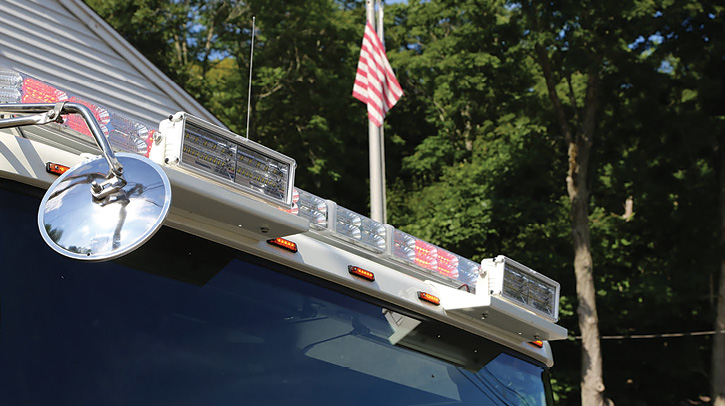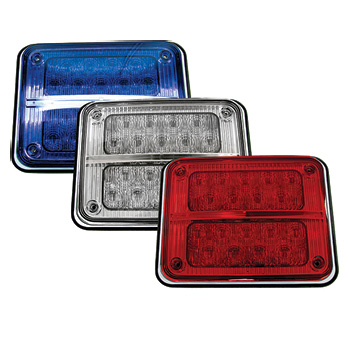A wide range of warning and scene lighting is available to make a fire apparatus more noticeable and more visible on the road and on a fire scene. In terms of noticeability, nowhere is the design of lighting more important than on the front of a rig.
Jonathan Sestrom, product manager for Whelen Engineering Company Inc., notes that recently there has been a lot of attention given to the illumination aspect on the front of fire apparatus. “Besides the light bars and other warning lights used on the way to an emergency scene, much greater attention is being given to scene and forward-facing lighting to create greater visibility when the apparatus pulls up to a scene,” he says. “These usually take the form of brow lights, which are essentially forward-facing light bars. For instance, we make the Pioneer Summit™ series of LED lights used on brow lighting to deliver maximum light intensity in a low profile, which are available in multiple spot, flood, and scene optic combinations.”

1 Whelen Engineering Company’s Pioneer Summit series of LED lighting is often used in brow light configuration on apparatus. (Photo 1 courtesy of Whelen Engineering Company.)

2 Safe Fleet’s FRC Crestlight, available in lengths of up to 72 inches, is often use in a brow light configuration. (Photo 2 courtesy of Safe Fleet.)

3 Sound Off Signal’s most popular light bar for the fire service is its nFUSE® xl light. (Photo 3 courtesy of Sound Off Signal.)
Whelen also makes the Freedom IV LED series of light bars in several models, Sestrom says: standard, with clear outer domes and color domes for center and end sections; Rota-Beam™ Super LED with four half corner beacons; DYAD models with corner modules that blend light for 360-degree contiguous light; and the compact Mini Freedom® IV.
Jason Witmier, director of education and technology for Safe Fleet, says Safe Fleet’s FRC division makes scene lighting for the front of apparatus and is focused on producing lighting that doesn’t blind oncoming traffic yet lights up an area to protect firefighters operating on a scene. He says FRC introduced a new generation of its Focus line, the Radiant Max and Radiant Lux, which now bend light through the fixture’s lens toward the ground directly in front of the rig. “The intensity of the light drops down up to 100 feet away,” Witmier notes. “It’s not about putting out the brightest light, it’s about getting the light into the area that’s most effective.”
Lou Zara, FRC product manager, points out that FRC’s Spectra series, both in the standard models and the Spectra Max version, are used in brow light configurations, as is the FRC Crestlight™ LED low-profile series. “The Crestlight series is a traditional style light that includes DOT marker lights,” Zara says. “It’s available in lengths of up the 52 inches and also comes in a 28-inch all-white LED model that can be top-mounted on the front or sides of a vehicle.”

4 The FireTech Omen warning light bar comes fully populated with every color in the middle row. (Photo 4 courtesy of HiViz LED Lighting.)

5 TecNiq’s K90 series warning lights are designed with Night Mode for nighttime operation and with AutoSync technology. (Photo 5 courtesy of TecNiq Inc.)
Starting at the roof, Sound Off Signal’s most popular light bar for the fire service is its nFUSE® xl light, according to Gabe Casucci, national sales manager, fire/EMS. “It’s a double-layered light bar with a typical industry look,” he says. “You can have upper and lower levels go from warning to all scene or you can isolate an upper or a lower level to go scene light on the bottom or warning light on the top and have them going at the same time. That gives you warning and scene all in the light bar.” The company also offers its mpower traffic controller that allows three colors in varying lengths. “You can have up to three colors, and they are in varying lengths,” says Casucci. “You can have ICC amber running lights steady, front directional if you’re at an MVA, and you can have full scene and warning all in one light head mounted to the brow under the lightbar.
Lightbars start at 24 inches and go to 72 inches. The traffic controller starts at 36 inches and goes to 70 inches. You can have fully populated or blank modules. Traffic controllers start at 36 inches all the way up to 70 inches. Sound Off’s most popular light in the Zone A is a 6 × 4 light. Also popular is a steady green light in Zone A for aerial buckets and aerial tips as a measure to cut through smoke environments and give an idea of a ladder’s location so the crew can see the ladder when working off of a roof.
Sam Massa, president of HiViz LED Lighting, notes that HiViz makes the 72-inch three-piece FireTech® LED brow light that’s available with optional integrated DOT marker lights and split circuits. “This multipart brow light is specifically engineered and designed with rounded cabs in mind, which allows greater access to the light,” he says.
HiViz also makes the Double Stack Minibrow Light with the same core extrusion technology as the FireTech brow light but using single-circuit solutions for use in any other area of an apparatus; the Single Stack Minibrow light; a recessed 19,000-lumen LED Minibrow area light; and the FireTech Omen warning light bar that comes fully populated with every color in the middle row to reduce complexity and eliminate the need for a department to configure the light, Massa points out.
Kevin Koyle, technical sales director for TecNiq Inc., says his company makes the E100 LED brow light that’s 14.16 inches wide by 5.3 inches tall and 2.12 inches thick and puts out more than 30,000 lumens. He says the E100 has 376 LEDs that provide efficiency and optimal light projection with reduced eye glare. TecNiq also makes the K90, K70 and K60 series of LED warning lights in 9- × 7-inch, 7- × 3-inch, and 6- × 4-inch sizes, respectively. All three models are designed with Night Mode for nighttime operation and AutoSync technology that allows the flashers to be synchronized without requiring a separate control box, Koyle adds.
ALAN M. PETRILLO is a Tucson, Arizona-based journalist, the author of three novels and five nonfiction books, and a member of the Fire Apparatus & Emergency Equipment Editorial Advisory Board. He served 22 years with the Verdoy (NY) Fire Department, including in the position of chief.

